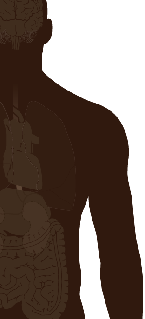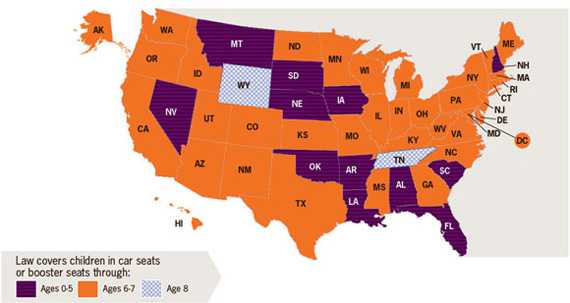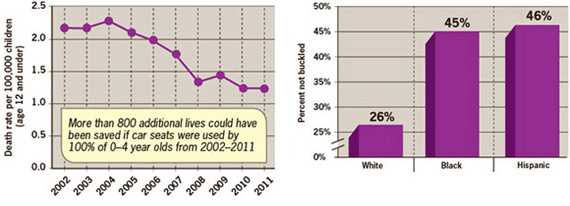Child Passenger Safety
Buckle up every age, every trip
On This Page
February 2014


 43%
43%
Motor vehicle deaths among children age 12 and under decreased by 43% in the past decade.
 9,000
9,000
Still more than 9,000 children age 12 and under died in crashes in the past decade.
 1 in 2
1 in 2
Almost half of all black (45%) and Hispanic (46%) children who died in crashes were not buckled up (2009 – 2010).
Motor vehicle crashes are a leading cause of death for children in the US. Buckling up is the best way to save lives and reduce injuries.
Child passenger restraint laws result in more children being buckled up. Only 2 out of every 100 children live in states that require car seat or booster seat use for children age 8 and under.
A third of children who died in crashes in 2011 were not buckled up. We—especially parents and caregivers—can do more to protect children on the road.
Parents and caregivers can keep children safe by:
- Knowing how to use car seats, booster seats, and seat belts.
- Using them on every trip, no matter how short.
- Setting a good example by always using a seat belt themselves.
Problem
Thousands of children are at risk on the road because they are not buckled up.
Crashes remain a leading cause of death for children.
- Crash deaths have gone down in the past decade (43% drop), but still more than 650 children age 12 and under died in crashes in 2011.
- One in 3 children who died in crashes in 2011 was not buckled up.
Many factors are related to whether or not children are buckled up.
- Of the children who died in a crash:
- More black (45%) and Hispanic (46%) children were not buckled up compared with white (26%) children (2009-2010).
- More of the older children (45% of 8-12 year olds) were not buckled up compared with younger children (one-third of 1-7 year olds; one-fourth of infants under 1) in 2011.
Evidence shows that state laws result in more children being buckled up.
Only 2 states (Tennessee and Wyoming) have child passenger restraint laws requiring car seat or booster seat use for children age 8 and under.
Child passenger restraint laws that increase the age for car seat or booster seat use result in more children being buckled up. Among five states that increased the required car seat or booster seat age to 7 or 8 years, car seat and booster seat use tripled, and deaths and serious injuries decreased by 17%.

SOURCE: Insurance Institute for Highway Safety, 2013
Note: Only age was used to determine child passenger restraint law coverage. Some states also have specific height and/or weight requirements.
View larger image and text description

View larger image and text description
Using the correct car seat or booster seat can be a lifesaver: make sure your child is always buckled in an age- and size-appropriate car seat or booster seat.

View larger image and text description
Keep children ages 12 and under in the back seat. Never place a rear-facing car seat in front of an active air bag.
Recommended age ranges for each seat type vary to account for differences in child growth and height/weight limits of car seats and booster seats.
Use the car seat or booster seat owner’s manual to check installation and the seat height/weight limits, and proper seat use..
Child safety seat recommendations: American Academy of Pediatrics.
Graphic design: adapted from National Highway Traffic Safety Administration.
What Can Be Done
Federal government is
- Developing, evaluating, and encouraging use of proven programs and policies.
- Providing parents and caregivers information on keeping children safe on the road.
- Tracking the nation's progress in getting children buckled up and reducing injuries and deaths.
Health care providers can
- Keep up-to-date on child passenger safety.
- Counsel parents and caregivers at each wellchild check-up:
- To use age- and size- appropriate car seats, booster seats, and seat belts on every trip.
- About the correct time to move a child to the next seat type or seat belt.
- Counsel patients of all ages about the importance and effectiveness of buckling up.
Parents and caregivers can
- Know how to use car seats, booster seats, and seat belts.
- Use them on every trip, no matter how short.
- Install and use car seats and booster seats according to the owner's manual or get help installing them from a certified Child Passenger Safety Technician.
- Recognize that the safest way to buckle up changes as a child grows.
- Buckle children age 12 and under in the back seat.
States and communities can
- Consider proven strategies for increasing car seat, booster seat, and seat belt use and reducing child motor vehicle injuries and deaths. Options for effective strategies include:
- Child passenger restraint laws that require car seat or booster seat use for children age 8 and under or until 57 inches tall, the recommended height for proper seat belt fit.
- Car seat and booster seat give-away programs that include education for parents or caregivers.
- Increase the number of certified Child Passenger Safety Technicians.
- Partner with researchers to develop and evaluate programs to address racial/ethnic differences in getting children buckled up.
Science Behind the Issue
Related Pages
- Vital Signs Issue details: Restraint Use and Motor Vehicle Occupant Death Rates Among Children Aged 0–12 Years — United States, 2002–2011, Morbidity and Mortality Weekly Report (MMWR)
- Child Passenger Safety
- Task Force on Community Preventive Services and the Community Guide: Use of Child Safety Seats
- Vital Signs – [PODCAST – 1:15 minutes]
- Vital Signs – [PSA – 0:60 seconds]
On Other Web Sites
- National Highway Traffic Safety Administration: Parents Central
- National Highway Traffic Safety Administration: Child Seat Inspection Safety Locator
- Insurance Institute for Highway Safety: Child Seat Laws
- Safe Kids: Child Passenger Certification Programs
- The Community Guide
- MedlinePlus – Motor Vehicle Safety
- MedlinePlus – Child Safety
- The Doctor’s Channel – CDC’s Top 3 Motor Vehicle Safety Tips for Doctors and Their Patients
- Page last reviewed: February 4, 2014
- Page last updated: February 4, 2014
- Content source:
- National Center for Injury Prevention and Control, Division of Unintentional Injury Prevention
- Page maintained by: Office of the Associate Director for Communications (OADC)


 ShareCompartir
ShareCompartir